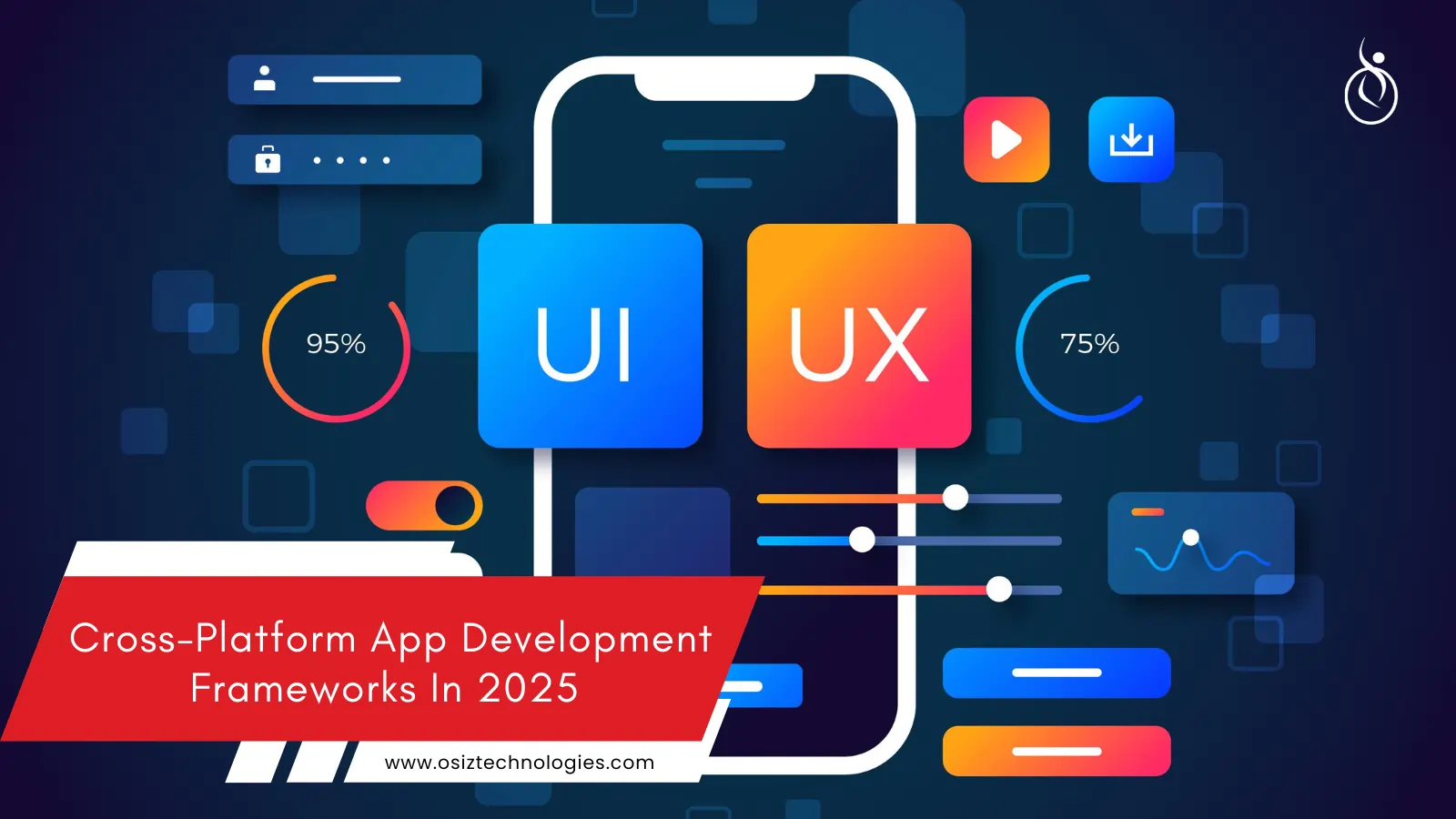Why Cross-Platform Development Still Dominates in 2025?
In 2025, making apps for all devices is key as it mixes quick build times, good run quality, and wide reach. With one set of code, makers can build apps that work well on Android, iOS, computers, wearables, and smart TVs.
This helps the app get to users faster and cuts down on the cost of making it a point no firm can look past in today's tough market.
New tools like Flutter, React Native, and.NET MAUI are coming up, offering nearly the same smooth use and look as if made for just one device, making app making for many devices the top pick for apps that grow and last.
Top Cross-Platform App Development Frameworks in 2025
1. Flutter
Backed by Google, Flutter still tops the charts in 2025 for apps that work on more than one system. It uses the Dart code language and has many ready-made parts for making good-looking interfaces.
With fast action, quick update features, and a big group of users, Flutter works great for making apps that grow on phone, computer, and net all from one set of code. Flutter 4.0, now out, works even better and links up with new tech like AI and AR.
2. React Native
Made by Meta, React Native stays a top pick with its JavaScript base and big group of makers. It’s quick to make things with parts you can use again and works with many other outside parts.
In 2025, React Native is stronger with better support for its native pieces, top UI speed, and smooth mix with back-end services—making it a good choice for both small and big companies.
3. Kotlin Multiplatform
Backed by JetBrains, Kotlin Multiplatform is picking up a lot of interest in 2025, mainly for teams working on shared parts across Android, iOS, and web apps.
It shares code but keeps the native UI separate. This gives more choices and better speed, mainly for teams already using Kotlin for Android or back-end code.
4. Xamarin (.NET MAUI)
Xamarin, now part of .NET MAUI, keeps being a strong choice for those who use C#..NET MAUI lets you make apps for Android, iOS, macOS, and Windows with one set of code.
With help from Microsoft, strong Visual Studio tools, and features for big businesses, .NET MAUI is a great pick for makers into.NET tech in 2025.
5. Unity (for Game & XR Apps)
Unity is still the main choice for making games, AR/VR, and XR apps that work on over 25 systems.
Widely used in 2025 in fields like gaming, cars, building, and health, it has a strong engine, real-time 3D skills, and a full store of things—key for great app experiences on many platforms.
6. Ionic with Capacitor
Ionic, with Capacitor, has a fresh way to make mix apps using web tech like HTML, CSS, and JavaScript. It feels like a native app and can use native device parts through Capacitor plugins.
In 2025, Ionic apps work better, react faster, and are easier to keep up, making it a solid choice for web makers moving to mobile and desktop.
7. NativeScript
By 2025, NativeScript is seen as a grown and bendy pick for devs who want full reach to the tools of a real phone while using well-known web dev tools like JavaScript, TypeScript, or Angular.
Not like mixed methods, NativeScript turns into real parts, giving high-speed apps that look and feel just like they’re built totally for the device. It now has more plugins, easier debugging stuff, and help for new frontend ways, making it a good choice for making apps for many types of devices without giving up control or how good they are.
8. Uno Platform
Uno Platform keeps picking up speed in 2025 by letting devs use their old C# and XAML code to make spot-on apps for many places like Android, iOS, macOS, Linux, and the web.
Uno's big plus is in making Microsoft's WinUI design talk work in a bigger circle, letting firms keep things simple in their dev pile while still acting true to each device. With more need for big apps that work well, Uno Platform is turning into a key thing for teams in the .NET group.
Use Cases: What Types of Apps Work Best with Each Framework?
Flutter
Google's kit to make apps that run on phone, web, and computer. Great for apps that need fast work and pretty, custom looks.
React Native
A JavaScript setup backed by Meta to make apps for more than one phone system. Good for apps that need quick updates, live features, and a real phone feel.
Kotlin Multiplatform
A flexible option from JetBrains to share how-to logic over systems. Best for groups using Kotlin and wanting to grow to iOS, web, and computer.
Xamarin / .NET MAUI
Microsoft's new version of Xamarin for making apps over platforms. Perfect for business fixes made with C#, aiming for mobile and computer.
Unity
A strong tool for making 2D/3D games and full XR fun. Ideal for games, AR/VR, and play-like setups over systems.
Ionic + Capacitor
A web-first setup using HTML, CSS, and JavaScript for phone apps. Best for mix apps and PWAs that want native work with web tech.
NativeScript
Make fully native apps using JavaScript, TypeScript, or Angular setups. Good for apps that want real phone work and deep device use.
Uno Platform
A C# and XAML setup that brings WinUI apps to all big platforms. Top for business and desktop-like apps aiming for wide platform use.
Emerging Frameworks Gaining Popularity in 2025
- Tauri
- SwiftUI for Multiplatform
- Jetpack Compose Multiplatform
- Expo SDK 50 (React Native-based)
- Capacitor 5
Why Choose the Right Framework for Your Project in 2025?
Picking the best cross-platform tool in 2025 hangs on your project aims, who it's for, your cash, and your tech set-up. If you want fast work with nice looking UI on both phone and desktop, Flutter gives top flex and runs well.
For groups good in JavaScript, React Native or Ionic with Capacitor make things move quicker with tools they know. Big apps linked to Microsoft tech do well with.NET MAUI or Uno Platform, and Kotlin Multiplatform is top for using the same biz logic without giving up native UI. Game makers or those into XR work should go for Unity.
Think about stuff like help from the community, tool reach, need for tying parts together, and how skilled your coders are. In 2025, there's not just one answer to the best tool is what fits your product dream, what users want, and what your team is good at.
Closing Thoughts
In 2025, cross-platform app development saw remarkable growth, proving it’s far more than just a cost-effective alternative to native app creation. Leading tools like Flutter, React Native, and Kotlin Multiplatform have evolved significantly, empowering developers to build high-performance apps with near-native functionality—all from a single codebase. These frameworks now offer modern UI capabilities and faster development cycles, making them ideal for today’s fast-paced digital demands.
What makes this evolution even more exciting is how widely it's being adopted. From startups aiming for a rapid launch to large enterprises streamlining app development, businesses across industries are embracing cross-platform solutions to deliver high-quality experiences on Android, iOS, desktop, and the web simultaneously. For a forward-thinking Blockchain Development Company, leveraging these tools means quicker deployment of secure, scalable apps across multiple environments.
As emerging technologies like AR/VR, AI, and foldable devices become mainstream, cross-platform frameworks are rapidly integrating support for them. The distinction between app types is fading, shifting the focus toward user experience, scalability, and development agility—key areas where blockchain and cross-platform innovation intersect.
Listen To The Article
Recent Blogs

Black Friday 30%
Offer










